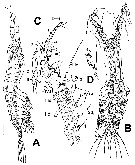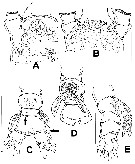|
|
 |
|
Monstrilloida ( Order ) |
|
|
|
Monstrillidae ( Family ) |
|
|
|
Monstrillopsis ( Genus ) |
|
|
| |
Monstrillopsis hastata Surarez-Morales & McKinnon, 2014 (M) | |
| | | | | | | Ref.: | | | Suarez-Morales & McKinnon, 2014 (p.303, Descr.M, figs.M, Rem.) |  Issued from : E. Suarez-Morales & A.D. McKinnon in Zootaxa, 2014, 3779 (3). [p.305, Fig.1]. Male (from 38°35.344'S, 144°59.687'E): A-B: habitus (lateral and dorsal respectively); C, left A1 (dorsal view; pattern elements described by Grygier & Ohtsuka, 1995); D, detail of paired processes on medial inner margin of 4th antennular segment. Scale bars: A, B = 200 µm; C = 100 µm. Nota: Cephalothorax representing 51% of total body length. A1 5-segmented, geniculate, representing 47 % of total body length (measured from the anterior end of cephalothorax to the posterior end of the anal somite) and 85 % of cephalothorax length. 3rd antennular segment bearing stiff seta IIIv, 4th segment with 2 nipple-like protuberances; terminal antennular segment modified, with inner rounded expansion and elongate distal half, latter sabre-like and representing 58 % of length of segment; inner expansion of this segment ornamented with 4 spinules. Oral papilla small, located anteriorly, about 27 % of way back along ventral surface of cephalothorax. Pair of relatively large ocelli present, pigment cups moderately developed separed by less than half eye diameter, weakly pigmented; ventral cup and lateral cups equally sized. P5 absent. 1 free postgenital somite; preanal and anal somites apparently fused with no trace of intersegmental suture. Genital complex of type II, with mammiliform distal tips of lappets. Spinous hyaline fringe posteriorly on dorsal surface of fused preanal+anal somites and free postgenital somite.
|
 Issued from : E. Suarez-Morales & A.D. McKinnon in Zootaxa, 2014, 3779 (3). [p.306, Fig.2]. Male: A, cephalic area (ventral); B, same (dorsal); C, urosome and caudal rami (dorsal); D, urosome showing genital complex (ventral); E, urosome showing P5 and features of genital complex (lateral). Scale bars: A-E = 100 µm. Nota: Forehead widely rounded, with 2 large sensilla and field of small cuticular papillae extending to most of cephalic area, including ventral and dorsal surfaces. Ventral surface of cephalic area bearing 2 pairs of nipple-like cuticular processes between A1 bases and oral papilla, 1 pair being small. 1st pedigerous somite incorporated into cephalothorax. Urosome consisting of 4 somites: 5th pedigerous somite, genital somite with genital apparatus, 1 free postgenital somite, and large anal somite possibly incorporating fused preanal somite. Ventral surface of genital somite forming enlarged base of cylindrical shaft with distal genital lappets. lappets represented by divergent pair of posteriorly directed cylindrical processes, each tapering distally into nipple-like process and reaching distal margin of anal somite. Anal+preanal somite large, representing 37 % of urosome, ornamented with posterior hyaline fringe of short spines on dorsal surface; similar ornamentation also present on dorsal surface of succeding free postgenital somite (arrows in fig.2C). Anal+preanal somite with irregular posterior margin in dorsal view. Caudal rami subrectangular, symmetrical, divergent, about 1.3 times longer than wide, each ramus bearing 4 setae.
|
 Issued from : E. Suarez-Morales & A.D. McKinnon in Zootaxa, 2014, 3779 (3). [p.307, Fig.3]. Male: A, P1 showing intercoxal sclerite; B, P3; C, P4. Scale bars =100 µm.
|
 Issued from : E. Suarez-Morales & A.D. McKinnon in Zootaxa, 2014, 3779 (3). [p.304]. Male: Armature formula of swimming legs P1 to P4. Spines = Roman numerals; setae = Arabic numerals.
| | | | | NZ: | 1 | | |
|
Distribution map of Monstrillopsis hastata by geographical zones
|
| | | | Loc: | | | S Australia (western Port Bay)
Type locality: 38°35.344'S,
144°59.687'E. | | | | N: | 1 | | | | Lg.: | | | (1149)* M: 0,81; {M: 0.81}
* Body length measured from the anterior end of cephalothorax to the posterior end of the anal somite. | | | | Rem.: | For Suarez-Morales & McKinnon (2014, p.304) this male is easily assignable to the genus Monstrillopsis by its possession of a distinctly modified 5th antennular segment, with an inner rounded protuberance and an attenuated, sabre-like distal half (Suarez-Morales & al., 2006); the position of the oral papilla far anteriorly on the cephalothorax; the fully developed eyes; the presence of 4 setal elements on the caudal rami.
This specimen has a reduced number of free postgenital somites compared to its congeners (1 instead of 2), the preanal and anal somites appear to be completely fused, without traces of an intersomite suture. This condition is usually found in males of Cymbasoma and has not been known to occur in Monstrillopsis except for incomplete fusion marked by a ventral suture and lateral constrictions in M. chathamensis and also in M. boonwurrungorum.
After Lee J. & al. (2016, p.421), male genitalia with a relatively short median shaft with its posterolateral corners extended as elongate lappets belong subgroup ''Type II'' (Suarez-Morales & McKinnon, 2014) | | | Last update : 07/12/2017 | |
|
|
 Any use of this site for a publication will be mentioned with the following reference : Any use of this site for a publication will be mentioned with the following reference :
Razouls C., Desreumaux N., Kouwenberg J. and de Bovée F., 2005-2025. - Biodiversity of Marine Planktonic Copepods (morphology, geographical distribution and biological data). Sorbonne University, CNRS. Available at http://copepodes.obs-banyuls.fr/en [Accessed October 22, 2025] © copyright 2005-2025 Sorbonne University, CNRS
|
|
 |
 |






